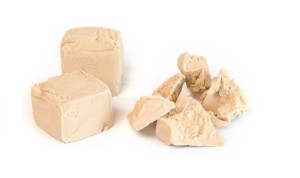
Yeast or brewer's yeast for pizza dough. The task of the yeast in the dough, and to increase the volume; for proving it means just that.
The increase in the volume of a dough is substantially due to the introduction of gas inside, This can happen in different ways.
If we prepare a sponge introduce air into when we incorporate the egg whites, while if we prepare cookies generally exploit a chemical reaction using a leavening agent (sodium bicarbonate or ammonium) che produce anidride carbonica.
Yeast or brewer's yeast for pizza dough
For bread and pizza, instead, using a leavening of biological. The production of carbon dioxide takes place by effect of the metabolism of the particular micro-organisms; there are two types of yeasts biological: the brewer's yeast and the so-called sourdough or natural.
The name is a bit 'confusing as any natural yeast is (in the sense that all exist in nature), but the name of "natural" means that around this type of yeast often develops an aura of "myth". So, the yeast is considered, no particular reasons, a more "organic".
The main difference between the yeast and the yeast is in the fact that while the first is composed of a single type of micro-organism, the second is a colony of many types of micro-organisms, many of which have complementary effects to those responsible for the rising and this means that a product made with natural yeast aromas and flavors develop richer, while improving the keeping quality and digestibility.
So better to use natural yeast for pizza? I would say no and I'll explain why.
- First, the natural yeast is much more complex to manage at home. Its creation and its proper maintenance require constant attention (is a bit 'like having a pet at home, maybe you do not need to take it out to make the needs, but he also wants to eat well and sometimes you have to give him a bath).
- The second downside is the lack of natural yeast consistent performance, particularly if it is not used very often (as is the case for example in a pizzeria).
- The third consideration is that the pizza is eaten freshly baked, and then the benefits on the shelf in this case we lose.
Brewer's yeast is rather simple to use and takes only a few rules to keep attention properly. The results are much more regular; if you really are a fan of sourdough, I recommend you not use it in place of yeast but in addition; in this way you can use the motor leavening of yeast and at the same time have the benefit organoleptic of the yeast.
Give birth to their own natural yeast is not complicated, but it requires a bit 'of time; if you are going to make the bread, worth having one on hand.
Let's go back to the yeast; the most common format is the dough from 25 grams of fresh yeast; You can also buy the yeast in dry form, but personally I do not recommend. When you buy the yeast, make sure that the expiry date is as far as possible and then hurry up and put it back in the refrigerator at 4 °.
You'll find that a loaf from 25 grams is an enormity of yeast, we'll be using very little; Once opened, however, the dough does not keep it more than a week wrapped in plastic wrap, then throw it well; seems like a waste if you always think that it costs about 25 cents, better to have it forever young and strong, a half-dead yeast will have a final result unsatisfactory.
The fresh yeast should be uniform beige color, if you notice parts with colorings "strange" try to eliminate them and look for a non-contaminated; generally the central part is less exposed to contaminants, and is therefore to be preferred.
Yeast or brewer's yeast for pizza dough
[RICH_REVIEWS_SNIPPET] Rate & review